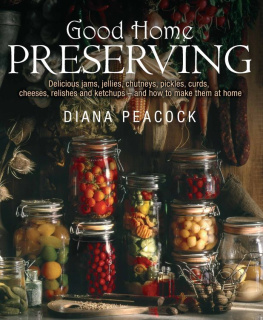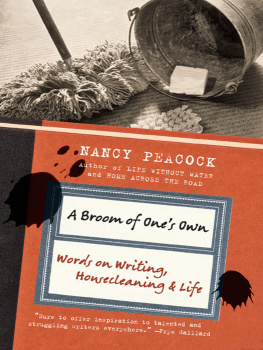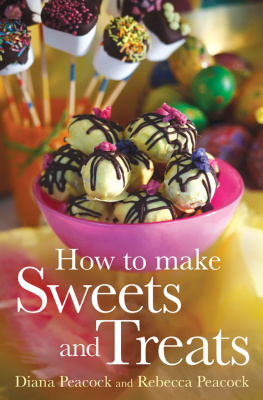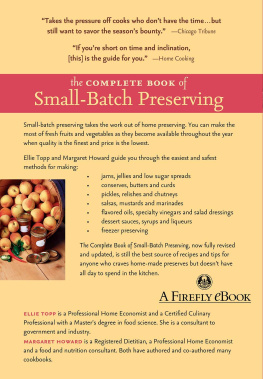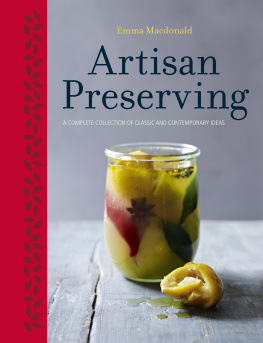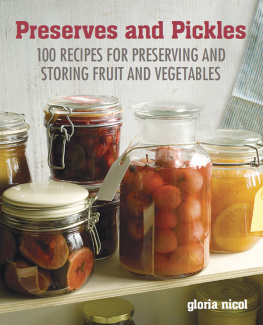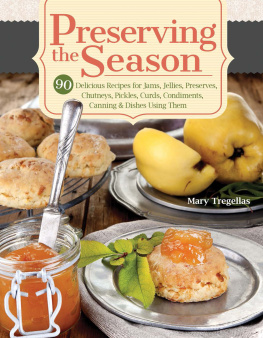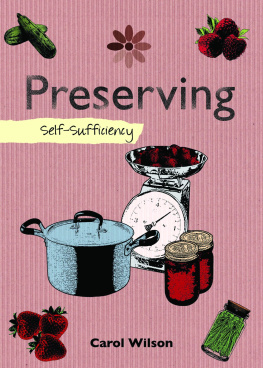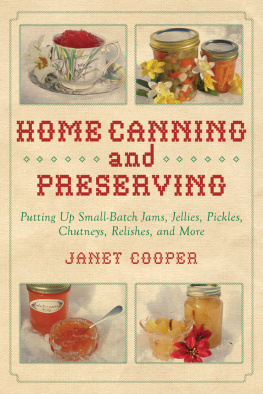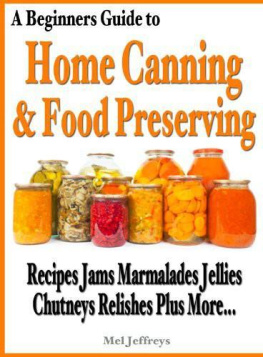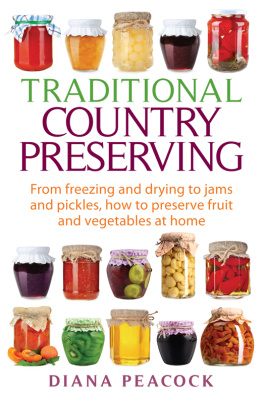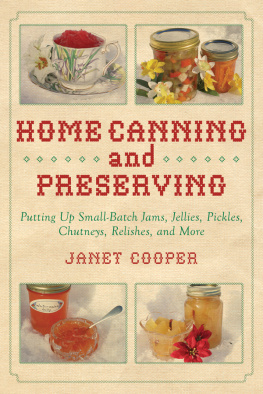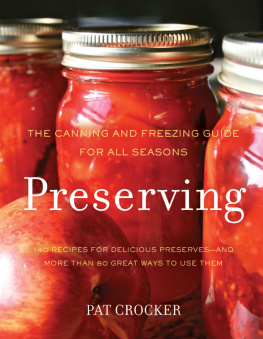Visit our How To website at www.howto.co.uk
At www.howto.co.uk you can engage in conversation with our authors all of whom have been there and done that in their specialist fields. You can get access to special offers and additional content, but most importantly you will be able to engage with, and become a part of, a wide and growing community of people just like yourself.
At www.howto.co.uk youll be able to talk and share tips with people who have similar interests and are facing similar challenges in their lives. People who, just like you, have the desire to change their lives for the better be it through moving to a new country, starting a new business, growing their own vegetables, or writing a novel.
At www.howto.co.uk youll find the support and encouragement you need to help make your aspirations a reality.
You can go direct to www.good-home-preserving.co.uk, which is part of the main How To site.
How To Books strives to present authentic, inspiring, practical information in its books. Now, when you buy a title from How To Books, you get even more than just words on a page.
Contents
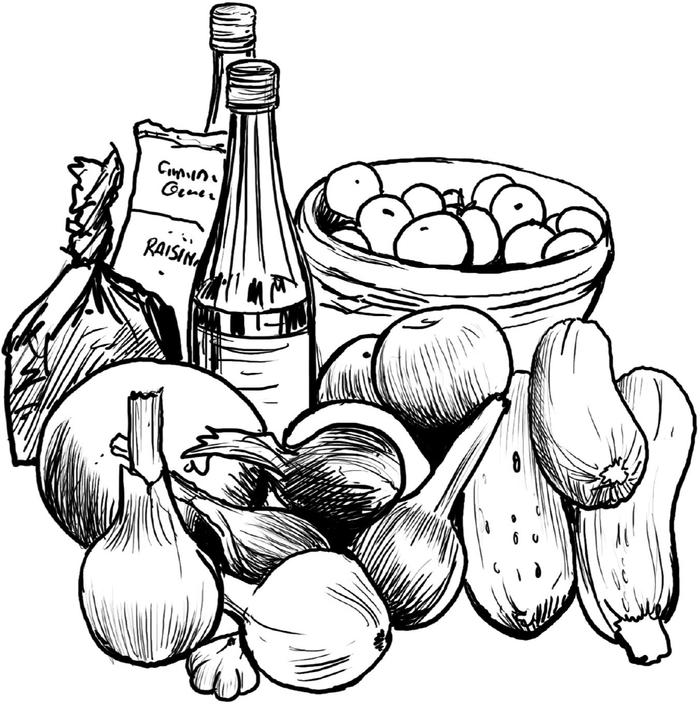
The preservation of our food has been of the utmost importance to our survival for hundreds of years, to feed us through the bleak winter months in Great Britain. From freezing and drying to jams and pickling, all have helped keep food edible, when fresh has been scarce. Though we have shops well stocked with food and provisions that enable us not to have to worry about the shortages of winter time, when you grow your own fruit and vegetables for whatever reason, it is both sensible for the planet and your pocket to preserve the produce in the best possible way. Now we are able to freeze food effectively and reasonably economically it means we can have almost fresh tasting fruit and vegetables all year round.
I find making my own jams and preserves both enjoyable and absorbing. Obviously it is very useful for using produce to its fullest and most productive, but it is also great fun.
Once you have mastered the art of making jams, chutneys and pickles and it isnt difficult to do so, you can begin to experiment and make up your own recipes to suit your taste and whatever you may have a glut of at any one time.
Jams and other preserves make great presents and gifts at any time, but I have found them most welcome at Christmas time when people are needing to entertain and tend to get through many preserves.
Never see preserving as a way to keep poor produce, it isnt worth it. All preserves need the best quality fruit and vegetables, ripeness will be down to what is required for each individual type of preserve. For example, some jams are best prepared with under-ripe fruit whereas the riper fruit is ideal for making jellies and syrups as the juice yield is higher.
Pride has always played an unashamed part in my preserve making, as I still get an inner glow when I say I made it myself and hopefully you will get to feel this way about your own home made preserves and thoroughly enjoy the process. It really is worthwhile.
OVEN TEMPERATURES
| C | Gas mark | F | Temperature |
| 130 | 250 | Very cool |
| 140 | 1 | 275 | Very cool |
| 150 | 2 | 300 | Cool |
| 160/170 | 3 | 325 | Warm |
| 180 | 4 | 350 | Moderate |
| 190 | 5 | 375 | Fairly hot |
| 200 | 6 | 400 | Fairly hot |
| 210/220 | 7 | 425 | Hot |
| 230 | 8 | 450 | Very hot |
| 240 | 9 | 475 | Very hot |
WEIGHT
| Metric (approx.) | Imperial |
| 2530g | 1oz |
| 5055g | 2oz |
| 85g | 3oz |
| 115g | 4oz |
| 140g | 5oz |
| 175g | 6oz |
| 200g | 7oz |
| 225g | 8oz |
| 250g | 9oz |
| 280g | 10oz |
| 350g | 12oz |
| 400g | 14oz |
| 450g | 16oz/1lb |
| 1kg | 2lb 4oz |
LIQUID MEASURE
| Metric (approx.) | Imperial |
| 2530ml | 1 fl oz |
| 50ml | 2 fl oz |
| 75ml | 3 fl oz |
| 100125ml | 4 fl oz |
| 150ml | 5 fl oz |
| 175ml | 6 fl oz |
| 200ml | 7 fl oz |
| 225ml | 8 fl oz |
| 250ml | 9 fl oz |
| 300ml | 10 fl oz ( pint) |
| 600ml | 20 fl oz (1 pint) |
| 1 litre | 1 pints |
Drying, along with salting, is one of the oldest known ways of preserving food. In hot climates it is also the most economical method. However, as we dont have a regular supply of sunshine available to us in Britain, it is better to dry produce indoors where a steady temperature can be maintained.
The two most important requirements for successful drying are a steady low temperature and ventilation. It is a lengthy process but once the produce is ready to be dried it takes relatively little work to achieve a product that will keep for many months.
What do I need to dry my fruit and vegetables?
You can purchase electric drying machines that are economical to run and take all the worry out of the task. Depending on how much produce you wish to dry, you can choose from a range of prices from about 70 to 450. These machines come with full manufacturers instructions.
Alternatively, you can use a conventional oven. This method will need more attention, but you can still achieve good results so long as you follow simple rules.
- Make sure your oven is available for many hours at a time as most foods take between 5 and 36 hours to dry out. They also require time to dry at room temperature before storing, so set aside a suitable space that is well ventilated and away from steam.
- The temperature needed to dry produce depends on what and how large the items are, but generally it is between 100120C/gas mark 1.
- Make a drying rack: take a cooling rack and stretch and secure a sheet of muslin over the top. The produce can be placed on top without touching to allow the warm air to pass around each piece.
Drying fruit
Stoned fruit plums, peaches and apricots are all suitable. Place whole fruit on the prepared tray and leave to dry for 2436 hours. Maintain the temperature until the skins have shrivelled. Leave for 12 hours in the air at room temperature to cool and allow any liquid to evaporate. Store in sterile jars.
Apples peel, core and slice into 5mm thick rings. Dip the rings in a bowl of lightly salted water and thread onto bamboo canes that will fit into your oven, resting on the side ledges. Leave the door of the oven slightly open. Drying should take about 5 hours, and then leave in the air for 12 hours before packing into sterile jars.
Drying vegetables
Peas and beans can be placed on the drying rack after blanching them for 4 minutes and drying them on a tea towel. They may be dried in the oven or in an airing cupboard. It will take about 4 hours for peas and 6 for beans. Leave them for 1 hour in the air before packing them into clean jars.

